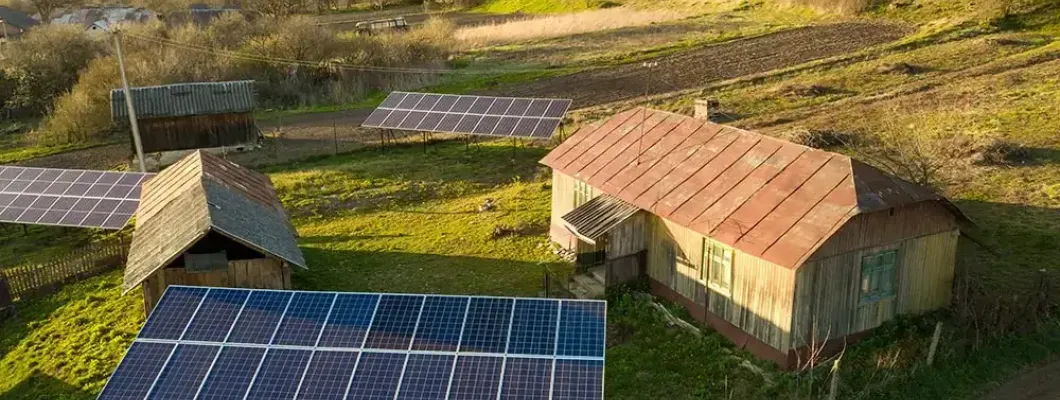Imagine flipping the switch on your brand-new off-grid solar system, only to find it fizzling out on a cloudy day. Don’t let your energy freedom turn into a budget-busting nightmare! Off-grid solar can slash your carbon footprint and ditch utility bills, but rookie mistakes can tank your plans. I’ve seen countless newbies trip over the same traps, so here are 10 common off-grid solar mistakes and practical tips to keep your system shining.
Why Go Off-Grid?
Off-grid solar systems power your home without a single cord to the utility grid, perfect for remote cabins or folks dreaming of energy freedom. But one wrong move—like picking the wrong battery or skipping a permit—can leave you powerless or broke. Let’s dive into the top 10 pitfalls and how to sidestep them.
10 Common Off-Grid Solar Mistakes (And How to Avoid Them)
1. Guessing Your Energy Needs
Mistake: Thinking a small system will power everything, only to face blackouts.
Fix: Dig through your last 12 months’ utility bills to pin down daily kWh usage.
Why It Matters: Undersizing your system means no power for essentials like lights or fridges.
Action: Track appliance use with an energy meter. A solo camper needing 10 kWh/day requires a 3 kW system in a 5-sun-hour area.
2. Picking the Wrong Battery
Mistake: Grabbing cheap batteries that fizzle out fast or demand constant upkeep.
Fix: Choose lithium-ion for long life (10–15 years) or AGM lead-acid for affordability. Read about common battery mistakes.
Why It Matters: The wrong battery can die early, costing you thousands to replace.
Action: Match your battery to your budget and system size.
3. Ignoring Sunlight in Your Area
Mistake: Not checking local sunlight hours, leaving your system underpowered.
Fix: Research average sunlight hours. Seattle’s 4 hours needs more panels than Arizona’s 6 for 10 kWh/day.
Why It Matters: Too few panels mean you’re stuck without power when the sun’s scarce.
Action: Check local weather data to size your system right.
4. Cheaping Out on the Inverter
Mistake: Buying a low-quality inverter that flops or wastes power.
Fix: Pick inverters with high efficiency (90% or above) from trusted brands.
Why It Matters: A bad inverter can cripple your system’s output or fail entirely.
Action: Check specs to ensure the inverter matches your system’s needs.
5. Ignoring Power Reliability
Mistake: Assuming solar alone will keep the lights on, even in winter or cloudy spells.
Fix: Plan for 2–3 days of battery backup or add a small generator for emergencies.
Why It Matters: Without backup, you’re left in the dark during low-sun periods.
Action: Size batteries for your area’s worst sunlight conditions.
6. Skipping Permits
Mistake: Installing without permits, risking fines or system takedown.
Fix: Research local building codes and hire certified installers.
Why It Matters: Unpermitted systems can lead to costly penalties or rework.
Action: Call your county office to confirm permit requirements.
7. Botching the Wiring
Mistake: Messy wiring that cuts efficiency or sparks hazards.
Fix: Use a multimeter to check polarity and pick the right wire sizes. See wiring tips.
Why It Matters: Bad wiring can cause short circuits or even fires.
Action: Follow manufacturer guides or hire a pro.
8. Blowing Your Budget
Mistake: No budget plan, leading to runaway costs.
Fix: Compare quotes on EnergySage. Consider certified used panels for savings.
Why It Matters: Overspending can derail your off-grid dreams before they start.
Action: Set a budget based on system size (small systems cost thousands, medium ones tens of thousands).
9. Choosing the Wrong Solar Panels
Mistake: Picking inefficient panels that underperform.
Fix: Opt for monocrystalline panels for higher efficiency, or polycrystalline for lower cost.
Why It Matters: Low-efficiency panels need more space and produce less power.
Action: Compare panel efficiency ratings before buying.
10. Skipping Maintenance
Mistake: Letting panels get grimy or batteries degrade unchecked.
Fix: Clean panels yearly and monitor battery health. Check battery maintenance tips.
Why It Matters: Neglect can cut your system’s lifespan by years.
Action: Use a soft brush for panels and check battery status regularly.
Cost Breakdown of an Off-Grid System
Here’s how costs typically stack up for a small off-grid solar system:
| Component | Percentage of Total Cost |
|---|---|
| Solar Panels | 30% |
| Batteries | 50% |
| Inverter | 10% |
| Charge Controller | 5% |
| Installation | 5% |
Source: Data from the Solar Energy Industries Association.
Ready to Go Off-Grid?
I’ve seen too many newbies lose thousands on simple slip-ups. Dodge these 10 mistakes, and you’re halfway to a rock-solid off-grid solar system. Start by checking your energy needs, compare quotes on EnergySage, and hire a certified installer. Want more on batteries or wiring? Check our guides on battery compatibility and wiring tips. Get started today, and make your solar dream a reality!
Frequently Asked Questions (FAQ)
How Many Solar Panels Do I Need for an Off-Grid System?
It depends on your energy use and sunlight hours. A 10 kWh/day household in a 5-hour sunlight area needs a 2–3 kW system (6–10 panels).
Are Off-Grid Solar Systems Expensive?
Small systems cost thousands, while medium systems cost tens of thousands. Compare quotes to find affordable options. Savings on utility bills can offset costs over time.
Is Off-Grid Solar Right for Me?
It’s ideal for remote homes or eco-conscious folks, but less practical in urban areas with cheap grid power. Assess your energy needs and budget first.
Which Battery Is Best for Off-Grid Solar?
Lithium-ion batteries last longer (10–15 years) but cost more; AGM lead-acid is cheaper but needs maintenance. See common battery mistakes for details.
How Much Maintenance Does an Off-Grid System Need?
Clean panels yearly and check batteries regularly. Lithium-ion needs less upkeep than lead-acid. Check battery maintenance tips for best practices.




Leave a Comment